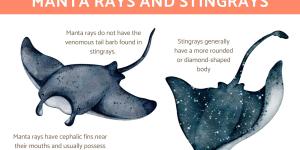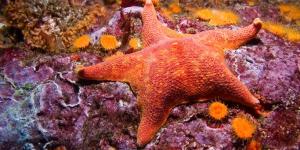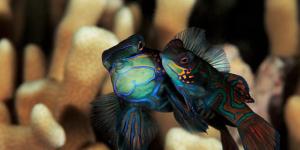How Are Manta Rays Born?

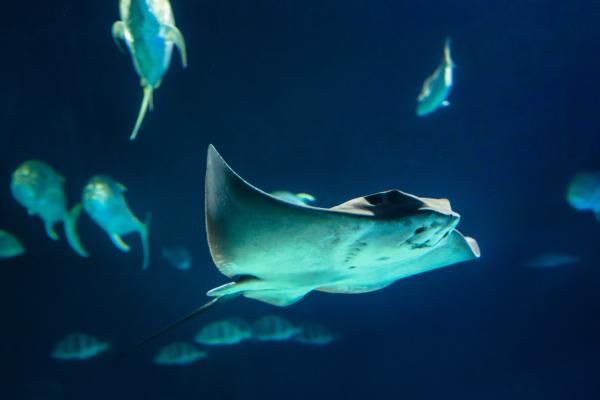
Manta rays are gentle giants, with distinctive fins and impressive size, have a fascinating reproductive process. Unlike egg-laying fish, manta rays give birth to live young, a sophisticated strategy. This journey, from conception to birth, exemplifies marine reproduction, involving complex courtship, internal embryo development, and uncommon maternal care for fish.
The following AnimalWised article explores how are manta rays born, reproduction, and the different stages of their life cycle.
What type of reproduction do manta rays use?
Manta rays are viviparous, meaning they give birth to live young rather than laying eggs. In their reproductive process, the female carries the developing embryo internally, and the pup is nourished through a yolk sac and later through uterine milk secreted by the mother.
Two distinct manta ray species inhabit our oceans, each exhibiting unique characteristics and reproductive patterns. Let us take a closer look:
- The giant manta ray (Mobula birostris) is the larger, reaching up to 7 meters (23 feet) in width. These pelagic rays traverse vast oceanic distances, often in deep waters. Their reproductive strategy reflects this nomadic lifestyle. Females possess the ability to store sperm, facilitating fertilization even during long migrations. This mechanism ensures reproductive success despite their wide-ranging movements.
- The reef manta ray (Mobula alfredi), smaller at a maximum width of 5 meters (16 feet), favors coastal habitats, including coral reefs and continental shelves. They exhibit site fidelity, frequently returning to specific cleaning stations and feeding grounds. This more localized behavior influences their reproductive patterns, typically resulting in more regular breeding cycles within established populations.
Both species share a reproductive strategy focused on individual offspring quality. That is, rather than producing numerous offspring, manta rays invest significant resources in developing a single, well-developed pup. Consequently, this approach, while resulting in a low reproductive rate, enhances the survival prospects of each individual offspring.
How do manta rays mate?
Manta ray mating rituals reveal fascinating aspects of their social behavior. During breeding seasons, females attract multiple males, and this attraction leads to the formation of what scientists call "mating trains." These formations can consist of 20-30 individuals, with males following a single female in a coordinated swimming pattern.
Consequently, these trains serve a dual purpose: they allow females to assess potential mates, while simultaneously enabling males to demonstrate their fitness and stamina.
Furthermore, communication during courtship involves both chemical and physical signals. For example, females release pheromones that males detect through specialized sensory organs. In turn, males respond with elaborate courtship displays, including barrel rolls, rapid acceleration, and precise positioning maneuvers. Then, females evaluate these displays, often leading to chase sequences that test male endurance and agility.
Moreover, environmental factors significantly influence mating behavior. While tropical populations, for instance, may breed throughout the year, those in temperate waters typically concentrate their breeding activities during warmer months. Additionally, many populations show increased mating activity during full moons, suggesting a lunar cycle influence on their reproductive timing.
Do manta rays mate for life?
No, manta rays do not mate for life. They are generally solitary animals that come together primarily for mating purposes. Females may mate with different males throughout their lifetime, and there's no evidence of long-term pair bonding between manta rays. This non-monogamous mating strategy helps maintain genetic diversity within manta ray populations.
Did you know that despite their similar appearance, manta rays and stingrays have distinct characteristics that set them apart? Explore their unique features in our related article.
How do manta rays reproduce?
Manta rays reproduce via ovoviviparity, especifically, aplacental viviparity, a reproductive strategy that enhances offspring survival.
Following internal fertilization, achieved when males use claspers to transfer sperm, the fertilized egg develops within the mother's uterus. This development occurs in distinct phases, showcasing manta rays' adaptation to live birth.
Gestation consistently lasts 12-13 months, during which the embryo undergoes significant changes. Initially, the embryo relies on yolk sac nutrients. Subsequently, the mother's uterus produces histotroph (uterine milk), a nutrient-rich fluid that sustains the growing pup for the remainder of gestation.
Finally, during late gestation, the pup develops its fins, gill structures, and sensory organs. This extended gestation allows complete development of these systems before birth, ensuring the pup's readiness for independent life.
How long does it take for a manta ray to reproduce?
In total, a female manta ray typically produces a pup only once every 2-3 years on average. For perspective, a female manta ray might only produce 5-8 pups over her entire lifetime, which can span 40+ years.
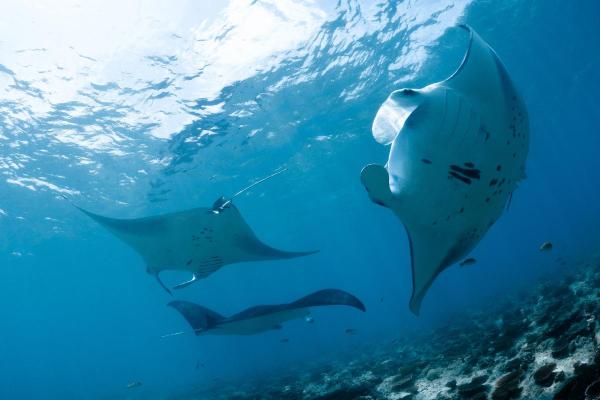
How are manta rays born?
Manta ray birth follows their long gestation. The mother gives birth to a single pup in open water, not necessarily shallow areas as previously thought. The pup's fins are folded to ease passage.
Newborn manta rays are miniature versions of their parents, measuring about 1.5 meters (5 feet) wide. Crucially, they are immediately independent.
Within seconds, pups swim and begin filter feeding on plankton. Because manta rays provide no parental care, this large size and self-sufficiency are vital for survival.
Did you know a single manta ray can filter thousands of gallons of seawater while feeding? Uncover more facts about their eating habits in our related article.
Life cycle of manta rays
The manta ray life cycle includes several stages . Newborn pups face predation from sharks and orcas, but their large birth size offers some protection. Quickly mastering swimming and feeding is essential for survival.
Growth rates vary by species and population, influenced by food availability and water temperature. Young mantas reach sexual maturity around 8-10 years old, with females maturing later than males. During this time, they grow significantly, some reaching 7-meter wingspans.
This slow maturation, combined with birth intervals of 2-5 years, means slow population growth. While this reproductive strategy has been successful historically, it makes them vulnerable to modern threats, such as: fishing, habitat degradation, and climate change.
After birth, baby mantas must navigate vast ocean spaces. Uncover where these amazing creatures thrive around the world in our related article.
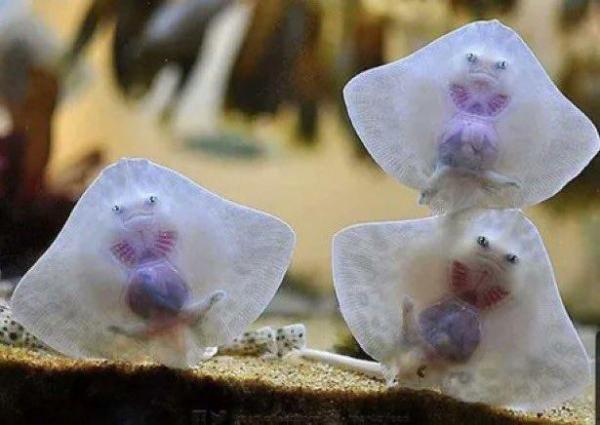
If you want to read similar articles to How Are Manta Rays Born?, we recommend you visit our Facts about the animal kingdom category.
- Couturier, LI, Dudgeon, CL, Pollock, KH, Jaine, FRA, Bennett, MB, Townsend, KA, ... & Richardson, AJ (2014). Population dynamics of the reef manta ray Manta alfredi in eastern Australia. Coral Reefs, 33, 329-342.
- Deakos, M. H. (2012). The reproductive ecology of resident manta rays (Manta alfredi) off Maui, Hawaii, with an emphasis on body size. Environmental Biology of Fishes, 94(2), 443-456.
- Stevens, GMW (2016). Conservation and population ecology of manta rays in the Maldives (Doctoral dissertation, University of York).

